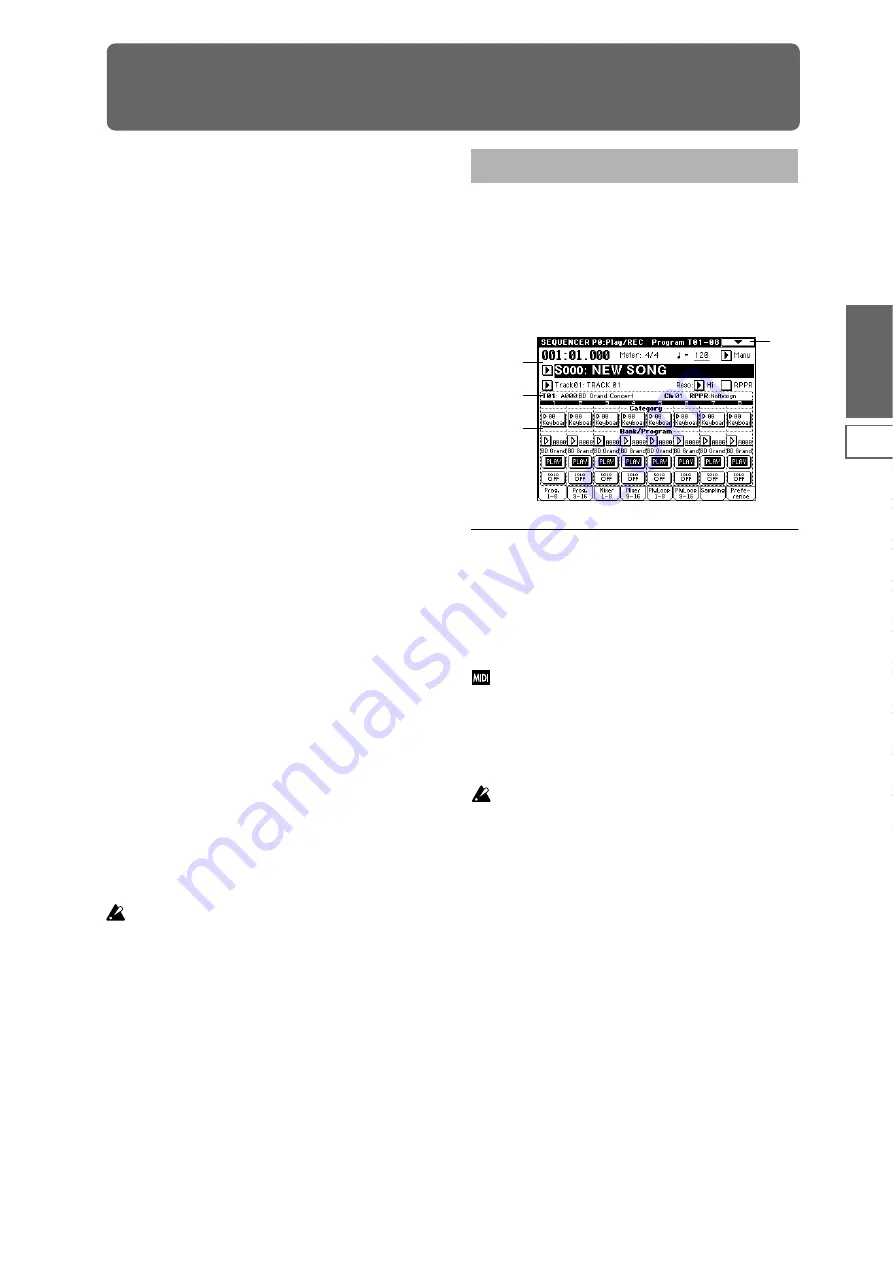
Sequencer
P0
P1
P2
P3
P4
P5
P6
P7
P8
P9
55
3. Sequencer mode
The Sequencer mode provides a variety of methods for you
to record, edit, and play back your songs using the built-in
16-track MIDI sequencer.
Each of the tracks can record your performance on the TRI-
TON Extreme’s keyboard, controllers, arpeggiator, and
RPPR (Realtime Pattern Play Recording) function, and play
back these performances using the sound of a program (or a
timbre in a combination). These tracks are able to record
exclusive messages and track parameters as well, and also
let you change sounds or effects during a song.
You can use these tracks to record data from an external
MIDI device, or use them to play external MIDI sound gen-
erators.
You can use a variety of methods such as event editing to
edit the MIDI data that has been recorded or loaded.
In addition to recording MIDI data on these tracks, you can
record and edit patterns. Patterns you create or the preset
patterns provided by the TRITON Extreme can be copied to
a track, or used with the RPPR function.
You can also use functions like Time Slice and In-Track Sam-
pling to create MIDI data that automatically triggers the
sampled data at the appropriate time.
The Time Slice function (Sampling mode “Time Slice” (Sam-
pling P2: 2–1B)) divides a rhythm loop or similar type of
sample into slices and simultaneously creates performance
data that will play the slices at the appropriate moment in
the song. This lets you change the tempo in Sequencer mode
without affecting the pitch of the rhythm loop. You can also
radically rearrange the rhythm loop to create your own
rhythms by editing the MIDI data to exchange note numbers
or adjust their timing.
The In-Track Sampling function lets you sample an external
audio source such as vocal or guitar connected to the
AUDIO INPUT (or your own playing on the keyboard)
while a song plays back, and automatically creates MIDI
note data to play that sample at the appropriate point in the
song. When you play back the song, the sample will then
play automatically at the right moment. This means that you
can use the sampling function essentially as a multi-track
audio recorder!
Songs you recorded in the ways described above can be
arranged in a Cue List to make them play back in the order
you specify.
Finally, a song you’ve recorded into the sequencer can be
resampled to media as a WAVE file, and burned to an audio
CD using a CD-R/RW drive connected to the USB A connec-
tor. (
Your settings and the song data you record are not pre-
served when you turn off the power. If you want to
keep your data, you must save it to media or a data filer
before you power-off. There will be no song data in
memory immediately after you turn the power on, so
you will have to load data before you can play or edit it.
0–1: Prog. 1–8
(Program T01–08)
0–2: Prog. 9–16
(Program T09–16)
Here you can make basic settings for recording and playing
back songs, and can select the program that will be used by
each track.
0–1a: Location, Meter, Tempo, Tempo Mode,
Song Select, Track Select, Reso, RPPR On/Off
Location
[001:01.000…999:16.191]
This display shows the current position in the song.
From the left, the numbers are the measure, beat, and clock.
When you modify these values, the current location will
change.
When “MIDI Clock” (Global P1: 1–1a) is set to Internal,
changing the location will cause Song Position Pointer
messages to be transmitted. Also if the “MIDI Clock”
parameter is set to External MIDI or External USB, and
“Receive Ext. Realtime Command” (Global P1: 1–1a) is
on, the location will change if a Song Position Pointer
message is received from the specified source.
The range in which the beat and clock can be modified
will depend on the currently specified time signature.
Meter
[**/**, 1/4…16/16]
This is the time signature at the current location of the song.
The time signature can be changed at each measure.
**/**:
This will be displayed when you press the
SEQUENCER [REC/WRITE] key. Specify this when you
wish to use the time signature that is already recorded for
that measure, and wish to record without changing the time
signature.
1/4–16/4, 1/8–16/8, 1/16–16/16:
This is the time signature at
the current location of the song.
Set “Track Select” to a Track 01–16, press the SEQUENCER
[REC/WRITE] key, and specify the time signature here.
When you press the SEQUENCER [START/STOP] key to
begin recording, the time signature you specify will be
recorded on the Master Track and on the already-recorded
tracks.
Be aware that if you press the SEQUENCER [START/STOP]
key during the pre-count to stop recording, the time signa-
ture will not be recorded.
Normally, you will specify the time signature when you
record the first track, and select **/** when recording subse-
quent tracks.
Sequencer P0: Play/REC
0–1
0–1a
0–1c
0–1b
Summary of Contents for TRITON Extreme
Page 1: ...2 E ...
Page 11: ...xii ...
Page 111: ...100 9 5 Page Menu Command 0 1A 0 1I 0 1J Program 9 5A ...
Page 185: ...174 ...
Page 215: ...204 ...
Page 281: ...270 ...
Page 349: ...338 ...
Page 350: ...339 ...
Page 351: ...340 ...
Page 352: ...341 ...
Page 353: ...342 ...






























